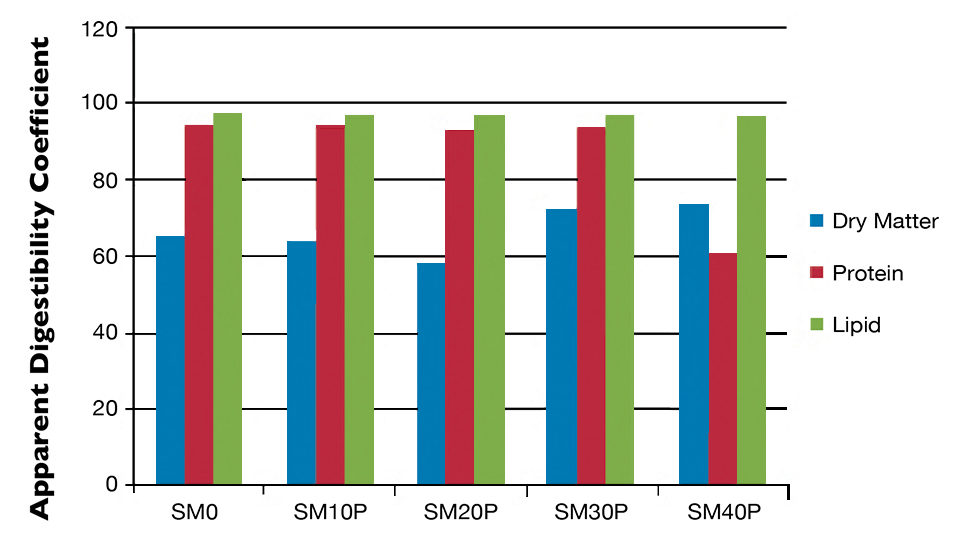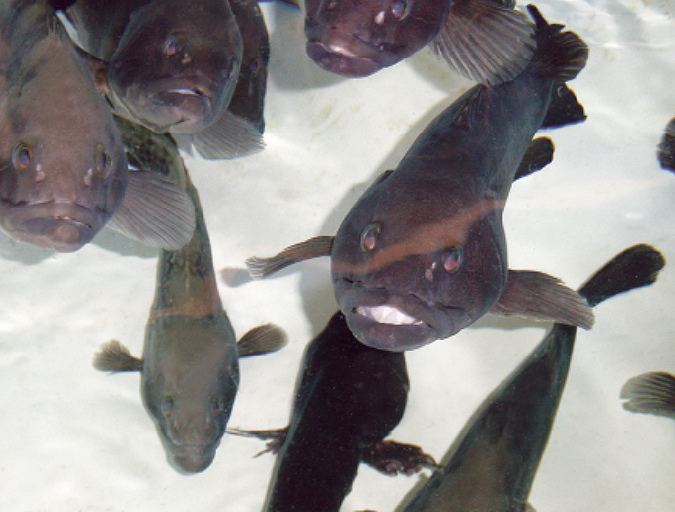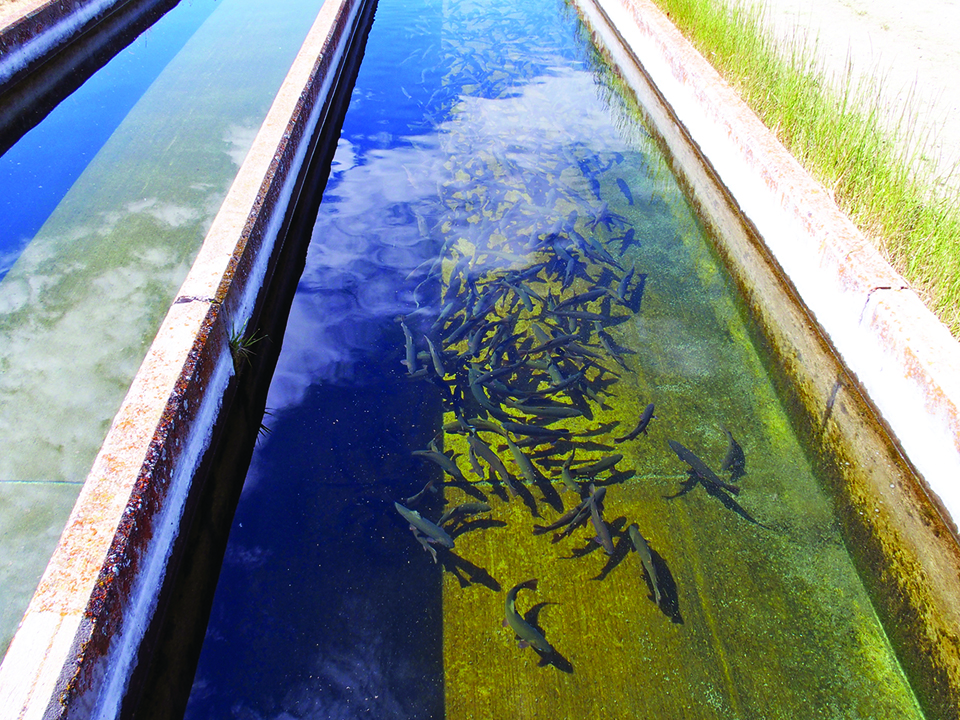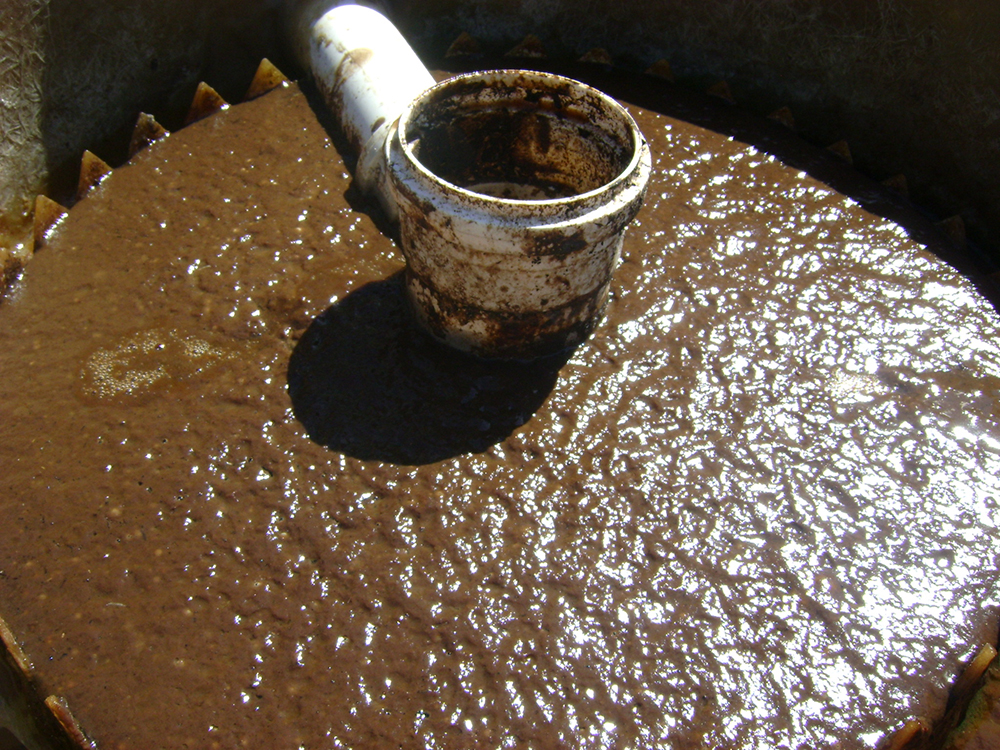Carnivorous species requires high protein levels in feeds

At present, soybean meal is the most important source of plant protein and comprises about 50 percent of the total oilseed crops of the world. Soybean meal is a preferred plant protein source due to its high protein content, currently lower price than fishmeal and steady production history.
Studies conducted on such marine fish species as spotted rose snapper, Asian sea bass, tiger puffer, sea bream and Japanese flounder have shown that soybean meal can replace fishmeal in diets at a level of up to 45 percent. However, not much information is available on the potential of soybean meal as a source of protein for groupers.
Grouper culture
Groupers have been identified as the most desired fish in the live reef food fish trade in Southeast Asia due to their desirable taste, hardiness in captivity, efficient feed conversion, rapid growth, high market demand and good price. Unfortunately, one of the limiting factors to the expansion of grouper culture is the high cost of feed.
Groupers are carnivorous fish that require high protein levels in feeds. Since the available pelleted feeds for tropical marine fish are mostly dependent on fishery-based ingredients, the feeds are becoming more expensive to produce. Replacement of fishmeal with a significant quantity of alternative ingredients is critical to reduce the feed cost.
At the Borneo Marine Research Institute at Universiti Malaysia Sabah, efforts to develop practical feeds with reduced amounts of fish-based ingredients for groupers have led to promising findings.
Anti-nutritional compounds
A well-reported constraint in utilizing soybean meal as a dietary protein source in fish feed is the presence of anti-nutritional compounds such as trypsin inhibitors and phytate. Unlike trypsin inhibitors, phytate is heat-stable and needs a phytase enzyme to improve its utilization. The presence of phytate in diets often results in negative effects on the growth, feed utilization and mineral uptake of the cultured fish. Soybean meal-based feeds are also facing issues regarding palatability and nutritional values.
Several approaches have been initiated to improve the utilization of soybean meal in aquafeeds through enzyme inclusion, amino acid supplementation and fermentation. At the Borneo Marine Research Institute, the performance of soybean meal-based feeds was improved with the inclusion of phytase in feed for juvenile tiger groupers, Epinephelus fuscoguttatus. Phytase is an enzyme naturally present in some plants and microorganisms, but not found in monogastric and agastric fish. Fortunately, commercial phytase is available for inclusion in animal feeds.
Feeding trials
The author performed two trials to evaluate the performance of tiger groupers fed soybean meal-based feeds and the effects of phytase inclusion in improving feed utilization. In trial 1, Danish fishmeal and defatted soybean meal were used as sources of protein. Industrial-grade fish oil and soybean oil were used as sources of lipid.
Feeds were formulated with 50 percent protein, 16 percent lipid and energy content of 365.8 kcal/100 g feed. Fishmeal protein was replaced with soybean meal protein at 0 (SM0), 10 (SM10), 20 (SM20), 30 (SM30) and 40 percent (SM40), and 20 percent plus phytase (SM20P) replacement levels. For SM20P, a phytase dose of 2,000 phytase units/kg enzyme was dissolved with water and added to the mixture of ingredients.
Fish weighing 13.9 ± 0.65 g were stocked at 10/tank in 150-L fiberglass tanks supplied with aeration using flow-through seawater system. The fish were fed the experimental feeds for 10 weeks.
In trial 2, the performance of soybean meal-based feeds was further evaluated with inclusion of phytase in the feeds based on the findings in trial 1. Similarly, five experimental feeds were formulated with the same protein, lipid and energy levels used in trial 1 but, except for the control feed, with soybean meal replacing fishmeal protein at 0 (SM0), 10 (SM0P), 20 (SM20P) and 30 percent (SM30P), and 40 percent with phytase supplementation of 2,000 phytase units/kg (SM40P).
Fish with an average initial body weight of 44.57 ± 0.28 g were randomly stocked into 15 cylindrical cages with 50-cm depth and diameter, and distributed in three, 5-ton fiberglass tanks. The fish were fed experimental feeds twice a day at satiation level for eight weeks. At the end of the trial, fish were transferred to experimental tanks for collection of feces and determination of apparent digestibility coefficient.
Fish performance
The essential amino acids such as methionine and lysine – the limiting amino acids in most plant-based feeds – were observed to be reduced with increasing soybean meal levels in the feeds. Methionine and lysine levels ranged from 0.92 to 1.53 percent and 3.28 to 3.75 percent, respectively. The lysine and methionine requirements of grouper were estimated to be 2.83 and 1.31 percent of dry feeds, respectively.
In the study, a methionine deficiency was observed when soybean meal was added above 10 percent in the feeds (Table 1). Interestingly, the growth rates of fish fed SM20 and SM30 were not significantly different from fish that received the control feed, which contained more methionine. Therefore, formulating feeds with up to 30 percent of soybean meal might be considered for rearing juvenile groupers, at least for a short period.
Shapawi, Amino acid composition, Table 1
| Amino Acid | Feed Treatment SM0 | Feed Treatment SM10 | Feed Treatment SM20 | Feed Treatment SM30 | Feed Treatment SM40 | Feed Treatment SM20P |
|---|
Amino Acid | Feed Treatment SM0 | Feed Treatment SM10 | Feed Treatment SM20 | Feed Treatment SM30 | Feed Treatment SM40 | Feed Treatment SM20P |
|---|---|---|---|---|---|---|
| Aspartic acid | 3.94 | 3.97 | 4.03 | 4.18 | 4.44 | 4.17 |
| Glutamic acid | 8.59 | 8.40 | 8.36 | 8.40 | 8.13 | 8.38 |
| Serine | 2.03 | 2.10 | 2.27 | 2.26 | 2.40 | 2.17 |
| Glycine | 4.44 | 4.60 | 4.75 | 4.72 | 4.92 | 4.65 |
| Histidine | 1.21 | 1.28 | 1.33 | 1.36 | 1.45 | 1.24 |
| Arginine | 2.50 | 2.88 | 2.94 | 2.99 | 3.20 | 3.07 |
| Threonine | 2.55 | 2.47 | 2.53 | 2.67 | 2.41 | 2.53 |
| Alanine | 2.74 | 2.49 | 2.44 | 2.47 | 2.31 | 2.43 |
| Proline | 1.87 | 1.87 | 1.94 | 2.01 | 1.94 | 1.93 |
| Tyrosine | 1.37 | 1.47 | 1.53 | 1.53 | 1.87 | 1.52 |
It was also observed that fish fed phytase supplemented-feed (SM20P) performed better than those without phytase supplementation (Table 2). In trial 2, growth rates were lower than in trial 1 due to the larger fish size used in the second trial. However, similar trends were observed in terms of weight gain, specific growth rate and feed conversion, where replacement of fishmeal with soybean meal at 40 percent consistently gave the poorest performance (Table 3).
Shapawi, Fish growth and feed conversion, Table 2
| Feed Treatment | Weight Gain (%) | Specific Growth Rate (%/day) | Feed-Conversion Ratio | Survival (%) |
|---|
Feed Treatment | Weight Gain (%) | Specific Growth Rate (%/day) | Feed-Conversion Ratio | Survival (%) |
|---|---|---|---|---|
| SM0 | 119.51 | 1.38 | 1.39 | 93 |
| SM10 | 92.89 | 1.15 | 1.72 | 93 |
| SM20 | 112.71 | 1.32 | 1.45 | 97 |
| SM30 | 115.18 | 1.34 | 1.54 | 93 |
| SM40 | 89.75 | 1.12 | 1.77 | 93 |
| SM20P | 116.57 | 1.36 | 1.42 | 90 |
Table 2. Fish growth and feed conversion in trial 1.
Shapawi, Fish growth and feed conversion, Table 3
| Feed Treatment | Weight Gain (%) | Specific Growth Rate (%/day) | Feed-Conversion Ratio | Survival (%) |
|---|
Feed Treatment | Weight Gain (%) | Specific Growth Rate (%/day) | Feed-Conversion Ratio | Survival (%) |
|---|---|---|---|---|
| SM0 | 80.3 | 1.03 | 1.25 | 98 |
| SM10P | 79.4 | 1.03 | 1.32 | 100 |
| SM20P | 81.4 | 1.04 | 1.33 | 98 |
| SM30P | 82.5 | 1.06 | 1.33 | 100 |
| SM40P | 72.9 | 0.96 | 1.47 | 98 |
Table 3. Fish growth and feed conversion in trial 2.
Feed-conversion rates were all below 2.0 in both trials, indicating efficient utilization of feeds by the fish. The survival rates of the fish were not affected by the inclusion of soybean meal in the diets. The apparent digestibility coefficients of the feeds are presented in Figure 1. The dry matter coefficients ranged from 64.3 to 74.2 percent. SM40P had the lowest crude protein digestibility coefficients. Meanwhile, the lipid digestibility coefficients of all experimental feeds was very high, ranging from 97.1 to 97.7 percent.

Perspectives
Finding alternative feed ingredients whose global production can keep pace with the growth of the aquaculture sector is critical to support the sustainability of this industry. Soybean meal is seen as the most promising protein candidate in formulated fish feeds, but thorough evaluation considering species-specific fish responses must be carried out to understand the full potential of soybean meal as an ingredient in aquafeed.
In general, the inclusion of soybean meal in feeds for groupers might be hindered by the limiting amino acids, reduced digestibility and palatability. Based on the current findings, the inclusion of soybean meal in grouper diets should not be above 30 percent of dry feed. However, inclusion of feed enzymes and attractants, as well as supplementation of amino acids, might be able to increase the utilization efficiency of soybean meal-based feeds. This will not only reduce the cost of aquafeed production, but also aquaculture’s dependency on fish-based ingredients.
(Editor’s Note: This article was originally published in the January/February 2015 print edition of the Global Aquaculture Advocate.)
Author
-
Rossita Shapawi, Ph.D.
Associate Professor/Director
Borneo Marine Research Institute
Universiti Malaysia Sabah
Jalan UMS, 88400 Kota Kinabalu
Sabah, Malaysia
Tagged With
Related Posts

Aquafeeds
Increased density improves grouper feeding response, growth
A growth trial using hatchery-reared grouper was carried out to study the effects of stocking density on feed intake and subsequent growth. Contrary to common perceptions, fish stocked at the highest density had higher feed intake and body weights.

Aquafeeds
A look at phospholipids in aquafeeds
Phospholipids are the major constituents of cell membranes and are vital to the normal function of every cell and organ. The inclusion of phospholipids in aquafeeds ensures increased growth, better survival and stress resistance, and prevention of skeletal deformities of larval and juvenile stages of fish and shellfish species.

Aquafeeds
Breaking the 20 percent soy barrier in fish feed
Reduced performance in fish fed high-soy feeds has been blamed on antinutrients, low methionine content and palatability issues. Pretreatment to inactivate anti-nutritional compounds and supplementation with amino acids improves soy-based feed performance, but not to control levels.

Aquafeeds
Crude protein and lipid from biofloc meals from an activated sludge system
A study compared the bioavailability of crude protein and lipid from biofloc meals generated with an activated sludge system using two water sources: wastewater from shrimp experimental culture (BFL-W) and, artificially, using clean seawater (BFL-C).


